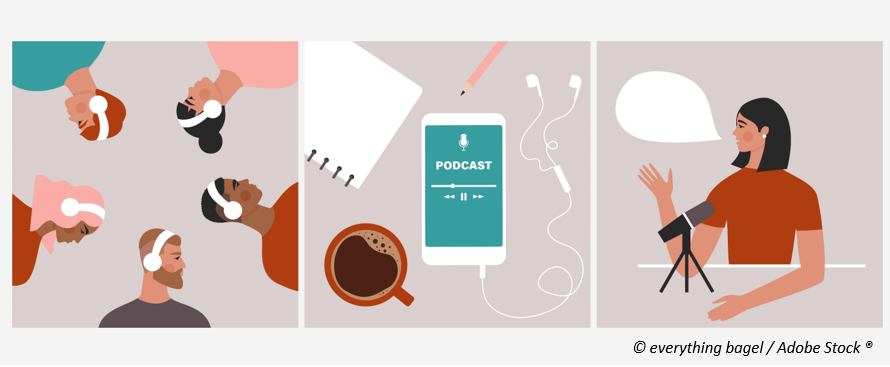Podcasting in training: a fad or a real pedagogical interest?
It is undeniable that the podcast is gaining in popularity. Everyday, 87% of French people listen to news in audio format(1). But can we learn from podcasts? Can we learn by walking down the street, without taking notes?
In a world where productivity has become the watchword, podcasts are popular, particularly because they can be listened to in parallel with another activity that does not require much in the way of attention, i.e. a controlled, automated activity, such as walking or running. The development of new technologies has also made them accessible everywhere: online and offline listening, regular reminders via a subscription, etc.
But what is a podcast?
A commonly shared definition is that of audio content broadcast or downloadable to all types of digital devices, with the subscription premise and repeated broadcasts.
Research has also focused on defining the podcast as applied to training. In his article, Peltier (2016) uses several classifications (Carvalho et al., 2009; Kay, 2012) to differentiate podcasts according to their purpose (to inform, analyse, develop, encourage meta-reflection…) and their effects (to increase interest, regularity, autonomy or reflexivity). Similarly, Kay (2012) has shown that podcasts make it possible to improve learning: to revise, prepare a sequence or enrich one’s notes, and this in a flipped classroom mode.
How do podcasts use training theories?
As such, we have come to the understanding that podcasts are popular with a wide audience, covering a wide range of content, which leads us to start
podcasting as well. But what if we now turn our attention to the pedagogical theories that support their use in training? Recent research in this area is sparse, but it is possible to apply several theories to the subject at hand.
Carré and Rieunier (2017) have drawn up an overview of general pedagogical principles in training, which are themselves linked to the major theories of training. Some of these
principles seem to be
related to the use of podcasts in training, especially in continuing education:
– Le principe de multimodalité, qui a d’ailleurs été traité dans un autre article de ce blog, repose notamment sur les travaux de Lieury (1996) et montre qu’il est plus efficace pour l’apprentissage et la mémorisation de diversifier les modes d’exposition d’un concept. Ainsi, associer le podcast (audio) à d’autres modalités (e-learning, présentiel, classe virtuelle…) pourrait contribuer positivement à l’apprentissage.
– The
principle of prior knowledge. This principle helps to guide the effective use of the podcast in a given device. Piaget’s constructivist theory (1964) postulates that our learning is built up cumulatively, over time and in relation to what we already know, at least to some extent. Thus, the podcast can be an effective option in a multimodal device, for example, upstream to introduce a topic, or downstream to reinforce it. We will come back to this notion in more detail.
– The
activity principle, which is central to training. As the name suggests, it implies active participation in the training. This activity is not necessarily physical (role-playing, flipped classroom…), it can be a matter of paying more attention to the words of a trainer for example. This principle is perhaps both an illustration of the great paradox of the podcast and an aspect we must be careful of. Paradoxically, the podcast’s great advantage is its “hands-free” aspect, which makes it possible to follow it, as we said, in parallel with other activities. However, in the context of a training podcast, it is difficult to consider that listening is “active” when you are playing football or cooking a Yorkshire pudding. In short, beware of distractions!
– Finally, the
principle of pleasure was particularly mentioned during our internal exchanges on the interest of the podcast in training. For many, it is pleasant and useful to follow podcasts. In terms of training, this notion overlaps with theories put forward by Deci and Ryan (2002), for example, on intrinsic motivation, which is specific to the individual, and which is based on the simple premise that we are more willing to commit to a system, and we learn better, when we enjoy it. It is therefore important to play on this lever of satisfaction that the podcast can constitute, including when dealing with training subjects. This point is also highlighted in a number of publications dedicated to podcasts in training.
The podcast seems to have strong arguments to justify its use in training. But what about in practice?
Focus on possible uses of podcasts
The great strength of the podcast is undoubtedly its flexibility. It is fully in line with the ATAWADAC mode of training consumption –
Any Time, Anywhere, Any Device, Any Content (freedom of time, space, equipment and content). This intrinsic flexibility offers the opportunity to train in one’s own way, with greater control over the pace and environment of one’s training.
By not relying on visuals, which is heavily used in educational videos, for example, the podcast relies on freeing up the listener’s attention bandwith, who can then fully engage in the listening activity. Indeed, when a visual support is not necessary for the participant’s understanding and integration of the content, active listening combined with note-taking, the importance of which we know, can appear to be a winning duo (which is in line with the principle of multimodality mentioned above).
A l’inverse, lorsque le choix est fait de diffuser des contenus multimédias (vidéos, e-learning…) lorsque ce n’est pas nécessaire, le risque réside dans le fait de pénaliser une ou des activités (écoute/visionnage/prise de notes), car le participant risquerait alors la surcharge cognitive, dont nous parlions dans un autre article.
In terms of pedagogical engineering, the temporal question of integrating podcasts into a training system is central, as it opens up a wide range of uses and objectives. At the beginning of a training course, it can fulfil the function of
teasing, raising awareness, or initiating the need or desire to learn. It can also aim to enable each participant to acquire, consolidate or correct their prior knowledge (pre-training), so that all participants find themselves in the classroom with the same level of knowledge, for example.
Proposé pendant la formation en écoute individuelle, il peut également jouer plusieurs rôles : celui de tuteur en reprenant et réexpliquant différemment des contenus complexes évoqués en amont, celui d’illustrateur, avec des exemples, ou encore celui d’enrichissement, en approfondissant certains contenus. Des controverses sous forme de podcasts ont été proposées et particulièrement appréciés dans le dispositif Camp’use.
At the end of the training or after the main system, it can be an opportunity to share testimonies, to formulate feedback, or to anchor the learning in time and in daily practice.
As always, it is the teaching method chosen that must meet the educational objective and not the other way round. But, as you will have understood, when used properly, we are convinced of the value of podcasts in training and we are working on it!
Camille Besson,
Educational Designer, Pierre Travaglini,
Educational Designer & Axel Azoulay:
Educational Engineer
Bibliography
(1) https://www.harrismedia.fr/les-chiffres-podcast/
Carré, P., & Rieunier, A. (2017). Chapitre 19. Psychopédagogie des adultes. Dans P. Carré & P. Caspar (dir),
Traité des sciences et des techniques de la Formation : 4
ème édition (pp. 383-400). Paris : Dunod.
Carvalho, A. A., Aguiar, C., & Maciel, R. (2009). A taxonomy of podcasts and its application to higher education. Dans H. Damis & L. Creanor (dir.),
ALT-C 2009 : In dreams begins responsibility – Choice, evidence and change : Proceedings of the International Conference for the Association for Learning Technology (pp. 132-140).
Deci, E. L., & Ryan, R. M. (2002).
Handbook of self-determination. USA : The University of Rochester Press.
Kay, R. H. (2012). Exploring the use of video podcasts in education : A comprehensive review of the literature.
Computers in Human Behavior, 28(3), 820-831.
Lieury, A., & Galvez, F. (1986). Le double codage des dessins en fonction du temps de présentation et de l’ambiguïté.
L’Année Psychologique, 86(1), 45-61.
Peltier, C. (2016). Usage des podcasts en milieu universitaire : une revue de la littérature.
International Journal of Technologies in Higher Education,
13(2), 17-35.
Piaget, J. (1964). Part 1 : Cognitive development in Children : Piaget development and learning.
Journal of Research in Science Teaching, 2, 176-186.








